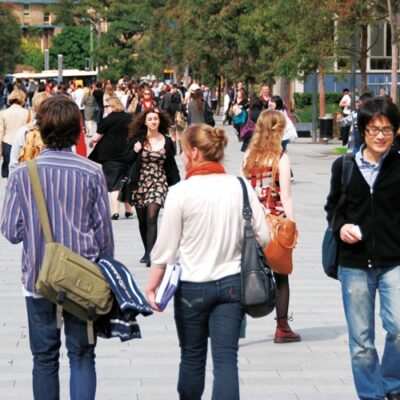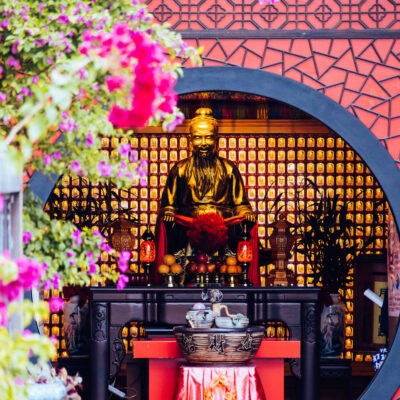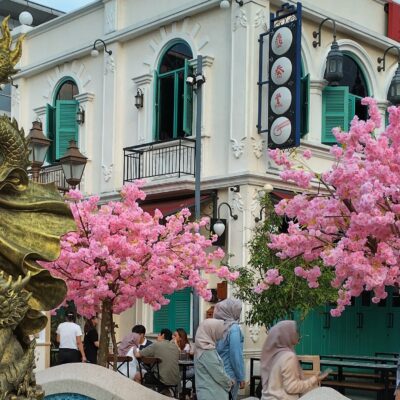Indonesian student numbers in Australia have been in freefall for decades. Scholars, teachers and education leaders have sought to solve this problem and their quest has garnered dramatic labels such as ‘holy grail’, ‘missing link’ and ‘perfect storm’.
If this quest ran on platitudes, we might have solved the problem. Last year, Prime Minister Anthony Albanese said, ‘more Australians speaking Bahasa Indonesia will be vital to deepening our relationship’. In 2013, Prime Minister Tony Abbott promised a foreign policy platform that would be ‘more Jakarta, less Geneva’.
But at the coalface of Indonesian studies, all this priyayi (elite class) Indonesia talk can feel a bit tong kosong nyaring bunyinya (‘empty drum makes the loudest noise’).
Enter the true heroes of our story—the wong cilik (the so-called ‘common people’ of Indonesia studies)—those Indonesian language teachers in Australia’s primary, secondary and tertiary classrooms.
A good story has imagination and emotion; and so do these teachers. In 2022, we spoke to many of these them, at conferences, in brainstorming sessions and in formal interviews (with nine secondary teachers from Australia’s second most populous state, Victoria). What we found were the makings of a powerful community with rich, complementary strengths. Here we set out these strengths, but also argue for better infrastructure to foster a fresh spirit of collaboration and community in Indonesian studies.
Indonesian teaching: the ‘flyover country’ of Australia-Indonesia relations
Government funding and messaging can leave Indonesian teachers feeling like they live in ‘flyover country’—a term used in the USA to refer to those vast parts of the country only visited by elites during election season, if at all.
The Australian government can do better on school funding. Funding works to build Indonesian teaching and learning, as scholar David Hill and Consortium Director of Australian Consortium for ‘In-Country’ Indonesian Studies Liam Prince have argued.
The Australian government’s National Asian Languages and Studies in Australian Schools Strategy (NALSAS) ran from 1995 to 2002. During this period, Victorian Certificate of Education (VCE) enrolments in Indonesian more than doubled (rising from 493 in 1995 to 1061 in 2002). In the six years after the NALSAS was scrapped, VCE student numbers dropped by a third (713). By 2021, Indonesian VCE enrolments had fallen to 444 students.
The Indonesian government can do better on funding, too. They do contribute to Balai Bahasa (‘Language Centres’), which run important events in the wider community. However, the Centres’ impact varies, relies on passionate individuals, and isn’t always felt at the school level:
‘It’s blatantly clear to us that the Indonesian government has no interest or no ability to fund any sort of stuff for the encouragement of [Australian] students connecting with Indonesia and Indonesian…That might not be the case that they don’t want that to happen, but for a student, there’s no evidence of that whatsoever.’ *Jo, Secondary School Teacher (*all names are pseudonyms)
The need for greater Indonesian government support has been forcefully argued by Flinders University scholar Firdaus, who critiqued Indonesia’s scant investment compared to that of China, France, Germany, Japan and South Korea. Firdaus points out, ‘No major language-teaching venture in Australia has been successful without the assistance of the home country’.
Australian government narratives of Indonesian do not always align with the interests and needs of those in flyover country—the Indonesian classroom.
Sure, it is heartening to hear Foreign Minister Penny Wong speak Indonesian. And the discourse around Indonesia being the fifth largest economy can influence parents. However, scholars such as Michelle Kohler and Yvette Slaughter have shown how the economic narrative is narrow, and doesn’t necessarily resonate with students. Moreover, government messaging is light on specifics.
Parents, teachers and students are keen to see explicit examples of Indonesian language success:
‘[Students] don’t really fully understand the proximity, and the importance of Indonesia, and how it’s going to be really important to Australia in their working careers. We need more support from the government to show there’s going to be options for them as they go into their careers.’ *Molly, Secondary School Teacher
Current messaging is most often heard from older politicians, businesspeople and Indonesianists. It rarely includes tangible, real-world examples of young, Indonesian-literate Australians using language skills to succeed in professional contexts.
Further, warnings from Australia’s Department of Foreign Affairs on Indonesia, while arguably necessary, create a culture of fear in school administrative circles. This only adds to the workload of time-poor teachers trying to develop new, youthful and contemporary content to inspire students.
‘We spend a lot of time on admin in schools, and on trying to create the right stuff to bring the kids in, but imagine the potential of what we could be doing in the classroom if we weren’t doing the busy work, if we had access to amazing, free online digital resources that enhanced what we were doing, that were current, that were up-to-date, and that showed young people [in interaction].’ *Jo, Secondary School Teacher
Indonesian teachers face challenges from all fronts (we have not even touched on curriculum and declining teacher numbers). The Australian and Indonesian governments could deliver more than platitudes.
However, for the rest of this piece, we focus on the imaginative, passionate and insightful teachers themselves. Whilst these teachers bring diverse and complementary skills to the classroom, more can be done to create infrastructure for them to succeed.
We are convinced that Indonesian language teachers—driven by concepts like gotong royong (‘mutual assistance’) and Bhinneka Tunggal Ika (‘unity in diversity’) —are especially well-suited to cultivate a national network of open educational practices.
Imagination, inspiration and infrastructure: open educational practices (OEPs)
Indonesian is not the only language struggling to gain recognition and support. We can learn from the successes of education and language programs facing similar issues in other parts of the world. These programs have brought together diverse educators to achieve diverse learning goals for diverse students.
We can begin by looking at the evolving field of open education—the free sharing of resources, especially online and through collaboration with others. One suggestion proffered in recent years has been the creation of a national, online learning bank of Indonesian materials. As noted in the teacher comments above, there is some appetite for the creation of contemporary, youthful and multimodal resources for use by teachers and students.
Moreover, we can create focused, sophisticated and targeted online materials by learning from the US STARTALK program. Founded post-9-11, STARTALK sought to cultivate interest in, and take-up of, so-called ‘critical need languages’ (e.g., Arabic, Chinese, Persian, Urdu). STARTALK’s resounding success is linked to its focus on teacher/student motivations in the creation of materials, and a critical concern with quality control/updating of materials.
So, a centralised, online learning bank is a step in the right direction. However, research shows that it is not enough. Earlier approaches to open education adopted an ‘if you build it, they will come’ approach to the creation of online open education resources (OERs).
But it has become clear this isn’t the case. OERs have proliferated but their take-up has lagged. We see some evidence for this among Indonesian teachers, who say of OERs, textbooks and materials more generally:
‘Too much out there and not enough…There’s stuff out there…but it’s just not well-organised in a way that’s accessible.’ *Josie, Secondary School Teacher
‘With teachers, we really don’t have the time [to find the right OER]’ *Susi, Secondary School Teacher
‘I certainly feel like there is a bit of a saturation…[and] you’re left to deal with, ‘how am I going to sequence this on my own on a campus where I am the only Indonesian teacher and I have to interpret a curriculum that’s vaguely written in the two-year band?’ *Mike, Secondary School Teacher
When it comes to trouble finding Indonesian materials, it can sometimes seem like an issue of curation rather than creation.
That’s not to say that new materials aren’t needed. Teachers are constantly refreshing what they do. They need to keep up with the interests of the students, the events of the day and a rapidly modernising Indonesia.
‘You should be talking about things that are happening just now. Kids like learning about, say, the new capital city or the G20 in Bali. All these sorts of things that the kids could find interesting and relevant, but there’s no resources you can just go to, you’ve got to make it yourself.’ *Richard, Secondary School Teacher
‘We need modern, up-to-date, digital resources that foster sameness [between Australians and Indonesians] as well as interest, that foster connection.’ *Jo, Secondary School Teacher
Indonesian teachers often create new materials in isolation—they are frequently the sole Indonesian teacher at their school, and many work in rural areas.
‘I see all the year 10 Math teachers catch up and they discuss ‘for this point of the curriculum, we have to hit this this and this’, and they agree on this particular point. That teacher will go away and do one part of it, this teacher will go away and do the other part, and then they’ve built like a course. Whereas with me it’s like I have to come up with the idea, I have to build the idea.’ *David, Secondary School Teacher
Moreover, many are unable to share their materials, or nervous about doing so.
‘I actually approach a lot of people and people are not sharing…I have to be honest, people are not sharing, not because they don’t want to share. It’s more because they’re not sure themselves if they’re doing the right thing with it.’ *Susi, Secondary School Teacher
Where earlier open education agendas focused on the creation of open education ‘resources’, open education ‘practices’ draw a closer focus on the importance of community, social interaction and sustainability. OEPs widen engagement, participation and inclusiveness in a community by bringing together individuals working toward a shared goal.
The appetite for collaboration to reach this goal is strong:
‘You know what would be amazing, if a group of teachers wanted to make a shift, and adopt something new, if they would be given the time and space to do it. To be given opportunities to work together and collaborate. Imagine that potential.’ *Jo, Secondary School Teacher
‘I’ve been thinking forever that I’d like to have a little network, of even just the schools in our area, that can come together just once a term, and build something.’ *Molly, Secondary School Teacher
‘I really want to invite teachers together, like just meet together. Okay, we want to know about [language related to] health topic[s], let’s sit together and brainstorm…Someone will share a listening [exercise], someone will have reading [exercises] and then we’ll just share together and then you’re ready to go to your class with so many options to pick.’ *Susi, Secondary School Teacher
OEPs create the context for collaboration—they are classic communities of practice, but with a centralised online presence and focused goals (infrastructure), and with sustainable OERs as outcomes. Indonesian teachers often create the same lessons in isolation, where organised OEPs create the context for doing it together. Moreover, as we show below, there is great appetite from academics, business leaders and others in Australia to help teachers, as much as teachers would like that help.
So, OEPs break down barriers between providers, users, organisers and sponsors by shifting the framing from ‘knowledge for all’ to ‘construction of knowledge by all’. OEPs entail a sharing not only of resources, but rather a sharing of complementary repertoires of skills.
In sum, OERs are certainly a great idea for the Indonesian context and some excellent OERs already exist. However, an even better idea is to create the collaborative infrastructure for sustainable OEPs; infrastructure that includes teachers, universities and keen outsider collaborators (discussed below).
Indonesian teachers are doing heroic work, but often in isolation. OEPs offer the chance to amplify and share this work and make it more collaborative and sustainable.
Guild planning/planting for sustainable OEPs
What would ‘good’ OEP infrastructure look like for Indonesian teaching? Data is key to knowledge management and OEPs. Moreover, many Indonesian scholars and advocates have argued for data on the attitudes and motivations of parents, teachers and students, and a responsive curriculum to meet these attitudes and motivations.
Yet, the simpler answer, for now, is that OEP infrastructure for Indonesian teaching looks like a well-planned, community garden.
The ‘garden’ should be planted in a central hub online, with some scope for physical meetings. It would ideally be placed at an institution with a sustained commitment to Indonesian engagement—the Monash Herb Feith Engagement Centre would be perfect. The Centre is a well-connected hub for Australia-Indonesia relations, and is comprised of researchers of Indonesian society and second language acquisition. Moreover, the Centre has already committed to host a project of this type.
‘Garden planning’ would be shared by key stakeholders with shared interests such as Indonesian teachers, teacher organisations, university programs and the Australia-Indonesia Centre (among others).
‘Garden planning’ would entail identifying priority goals and facilitating the right people for these goals. The strength of OEPs come from passionate, skilled and engaged people who sustain them, and creative solutions that emerge when they do. It would also involve something similar to ‘guild planting’ which refers to the positioning of plants that do not compete for resources, but rather help one another flourish as gotong royong (‘mutual assistance’).
Indonesian teaching networks are diverse in terms of resources, experience and other matters. Some teachers have access to more resources than others and some have more direct access to Indonesia than others (e.g. through exchange or as native speakers).
‘One of our issues is possibly those who ‘know more’ and those who are just doing their best. Inner and outer circles are probably inevitable.’ *Josie, Secondary School Teacher
Some teachers (‘inner circle’ here) have access to more resources than others. Some (again, ‘inner circle’) have more direct access to Indonesia than others (e.g. through exchange or as native speakers).
Indonesian skills, resources and teaching styles do not always match up and nor should they. But another way to look at this is as an abundance of complementary possibilities that can be brought together: Bhinneka Tunggal Ika (‘unity in diversity’).
We see these opportunities in interviews with Indonesian teachers. Older teachers represent decades of pedagogical and classroom experience and, consequently, valuable resources to the wider teacher network.
Younger teachers are also valuable resources. Many are alumni of Australia’s most successful exchange programs, e.g., Australian-Indonesian Youth Exchange Program (AIYEP), the Australian Consortium for In-Country Indonesian Studies (ACICIS) and the Australia Indonesia Youth Association (AIYA).
Younger teachers, often working in isolation, draw on Indonesian social networks when planning lessons:
‘I still keep in touch with [Indonesian friends I met on exchange via] Instagram or Whatsapp or whatever… ‘can we Zoom and I record you just saying this one thing’ or stuff like that… I don’t really know many teachers other than my old teacher, the teacher that used to teach in my school, so I don’t really communicate with other teachers in the state or in the country.’ *David, Secondary School Teacher
Both groups show a desire for authentic resources that represent younger, contemporary Indonesia. These young teachers are an untapped resource and are keen to collaborate with others.
OEPs have been wildly successful in other parts of the world. For instance, Rice University’s OpenStax project has been co-created through collaborations between teachers, students and professionals, and now boasts 6.5 million users from 140 countries.
OEPs might seem unrealistic at the outset in Australia, but Indonesian teachers, researchers and professionals are already doing it—just not in a long-term and co-ordinated way.
Grassroots, technology and longevity: moving OEPs into the open and sustaining them
At university, we have the privilege of interacting with students, teachers and professionals in the Australia-Indonesia relationship. We see the power of collaboration to work toward innovative solutions. However, we also see how these discussions and solutions quickly fade into obscurity—words rarely written up or reaching beyond the conference or workshop in which they are spoken.
OEPs can extend the life of these discussions and solutions by putting teachers, academics and other Australia-Indonesia stakeholders into the same orbit. It is a long-standing finding of sociology that information flows, innovation and even professional success proliferate when people form ties with those outside of their immediate social or professional orbit.
We have seen the power of these so-called ‘weak ties’ in many Australia-Indonesia spheres. For instance, one ongoing discussion in recent years has been how to better connect Australia’s Indonesian diaspora and Indonesian teachers/teaching. Participants of the most recent Australia Indonesia Youth Exchange Program (AIYEP) recently held a focused discussion on this topic.
AIYEP delegates proposed a joint ‘IndoFest’ incursion event for local schools, driven by the Indonesian consulate, Monash University and Victorian Australia-Indonesia organisations. This hypothetical event would be not unlike the Indonesian diaspora’s ‘Diaspora Fair’—including food, dancing and other cultural showcases—but it would more directly engage with Australia’s Indonesian students.
Another common refrain has been how to find ‘Indonesia’s K-Pop’—what is the popular culture or other hook that interest Australia’s young people? We’ve put this question to many experts, who have given excellent answers.
In 2022, Thomas Baudinette—a K-pop fandom expert from Macquarie University—spoke at the Asian Studies Association of Australia Conference about how pan-Asian pop culture enabled Australians to develop cosmopolitan identities beyond ‘white’ Australia. Baudinette explained how he tapped into this to excite students about Asian literacy. In his classes, students often consume Asian pop-culture in a way that makes them feel more empowered as ‘Asia literate’, and gain a better understanding of themselves as diverse Australians.
At the same roundtable, ReelOzInd! Fellow Jemma Purdey spoke about her ongoing collaboration with Indonesian teacher Deryn Mansell. Purdey and Mansell have co-created online teaching resources (primary school to the final year of secondary school) to accompany short films submitted to the annual, Australian-Indonesian ReelOzInd! film festival.
We took the pop culture/Indonesia question to young Australian professionals working in Indonesia. One narrative that emerges is that perhaps we’re looking too hard for some new, modern and external (e.g., K-pop) frame for Indonesia, instead of embracing what actually draws students, teachers and professionals to Indonesia (e.g. the diverse intersection of modern and traditional Indonesia):
‘I live in a fancy apartment I’m on the 22nd floor I’m like looking out onto these massive buildings on [a main street in Jakarta]. Almost every afternoon I hear gamelan from the streets below…it’s down there like in the kampong basically being played. So even though we’re in this like mega metropolis and it’s all about like what is modern culture, that traditional cultural stuff is still a core element of like Indonesia so I think you need both.’ Clarice Campbell, Lead Skills Advisor, Katolis, AIYA President
From the perspective of some professionals (and harking back to teacher comments about the need for more ‘younger voices’ in the curriculum), we’ve just not done well enough in setting out what is exciting about Indonesia, and the way in which young, successful, Indonesian-literate Australians have engaged with it.
The Indonesian space is full of discussions and resources, such as this book by Dwi Noverini Djenar, Michael Ewing and Howard Manns (free) on Indonesian youth language, or this lesson on Indonesian metal by Jess Kruk.
But it can be difficult to track down these discussions and resources and conversations addressing these topics are often ephemeral—limited to conferences, workshops or social media.
We need to create a central, well-curated and sustainable hub, where Indonesian teachers can interact with one another, universities and other stakeholders in the Australia-Indonesia relationship. We see glimpses of what a well-curated site might look like in the form of Purdey and Mansell’s site above. However, the take-up and sustainability of OERs relies on engaged OEPs. We see a ferocious appetite for collaboration between teachers and stakeholders, but we also see the need for a centralised context within which this can take place (we would propose, a centralised, online infrastructure).
Long-time lecturer Paul Thomas pointed out:
‘Pragmatically inspired government initiatives need to make the transition to more comprehensive, grass roots forms of engagement…A broadly engaged community of learners is more likely to sustain language and culture programs capable of making a difference in the relationships between nations.’
Indonesian teaching in Australia desperately needs funding, even to begin a hub of the type we are talking about here. However, the Indonesian teaching space can also feel a bit like flyover country, and it has become clear that even if the funding comes, it might not stay for long. We need to future-proof any concept.
To these ends, it seems like much can be gained by learning from successful programs in other parts of the world. OEPs have emerged as a powerful way to create sustainable OERs. Further, the successes of the US STARTALK program can be found in making sure we capitalise on our understandings of teacher and student motivations, and integrate these into our OEPs. While there has been much talk about the ‘holy grail’ and the ‘missing link’ of Indonesian studies, one thing that has struck us is that maybe we’re already doing the right thing—we’re just not doing it sustainably nor are we doing it enough together.
*all names are pseudonyms
Authors: Dr Howard Manns, A/Prof Michael Ewing, A/Prof Sharyn Davies and Dr Jess Kruk
Image credit: Kenny Eliason on Unsplash




